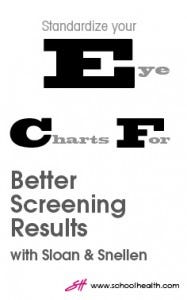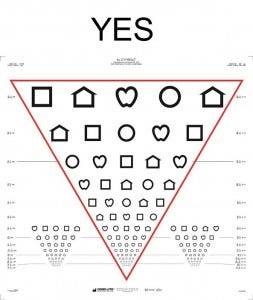Are Your Eye Charts Up to Date? The Evolution of Eye Charts Over the Past 150 Years
- Jun 21, 2015
- 0 Comments
 Eye charts are an important part of vision screening, but how did these vision screening tools look in 1915? What about 1862? The answer may surprise you.
Eye charts are an important part of vision screening, but how did these vision screening tools look in 1915? What about 1862? The answer may surprise you.
When you think of the word “Snellen,” you probably think of Snellen’s legacy – the Snellen Eye Chart with the big "E" at the top. This chart continues to hold a place of prominence on many walls in school nurse's offices and in the hallways of medical practices today.
Snellen, a Dutch ophthalmologist, introduced the first version of his eye chart in 1862, as a way to determine visual acuity (Bennett, 1965). Recently featured on CBS Sunday Morning, Snellen's work set a new standard for vision screening. His Snellen Eye Chart and the Snellen Ratio are still in wide use today.
Before 1862, oculists used varied and sometimes interesting methods to assess visual acuity.
When the first school setting vision screening program began in 1899, a Snellen chart was used. (Appleboom, 1985) Many versions of eye charts have come and gone over the years, and even today's version of Snellen's chart differs from the 1862 version.
But did you know that the time-honored Snellen chart is not the preferred letter chart for testing visual acuity in 2015?
Why is a Snellen chart not the preferred chart of 2015?
While Snellen charts revolutionized vision screening programs they do not adhere to national and international guidelines for standardized eye chart design (Nottingham Chaplin & Bradford, 2011). Six guidelines for standardized eye chart design are (Nottingham Chaplin & Bradford, 2011):
- Optotypes should be of approximate equal legibility.
- Each line on an eye chart should have the same number of optotypes (typically 5).
- Horizontal spacing between optotypes should be equal to the width of the optotypes on a line.
- Vertical spacing between lines should be the height of the optotypes in the next line down.
- The size of optotypes should progress geometrically up or down the chart by 0.1 log units (i.e., 20/32 vs. 20/30).
- Optotypes should be black on a white background under good lighting conditions (luminance between 80 cd/m2 and 160 cd/m2).
If you were to draw a line around the outside of the ototypes on an eye chart adhering to the national and international guidelines, you would see a chart with an inverted triangle. Conversely, if you outlined the optotypes on a chart that does not adhere to national and international guidelines, you would see a chart with a rectangle.

So, look at the eye chart
 you use. Do you see the inverted pyramid or a rectangle?
you use. Do you see the inverted pyramid or a rectangle?What should we use instead of Snellen charts for Vision Screening?
Despite many state, public health, & district vision screening guidelines listing Snellen as the preferred chart for school aged children it has been recommended to use Sloan charts for vision screening.
Developed by Louise Littig Sloan, phD, and Dr. Palmer Good, of The Good-Lite Company, the preferred tests of visual acuity for school-aged children and adults use Sloan Letters as optotypes.
Sloan published information about those letters in 1959 (Sloan, 1959). which was later used by vision professionals to design a new, standardized chart in the inverted pyramid format.
It is recommended to switch from Snellen to Sloan charts to ensure an evidence-based test of visual acuity for school-aged children that meets national and international design guidelines for standardized eye charts.
School Health offers a variety of Sloan charts and cards that meet the national and international guidelines. Call us today for a consultation on the Sloan-related screening products that are available to you.
Shop Sloan & Snellen Charts & Cards>>
Request a FREE Vision Screening Consultation>>
Resources:
Appelboom, T. M. (1985). A history of vision screening. The Journal of School Health, 55(4), 138-141.
Bennett, A. G. (1965). Ophthalmic test types. A review of previous work and discussions on some controversial questions. The British Journal of Physiological Optics, 22(4), 238-271.
Nottingham Chaplin, P. K., & Bradford, G. E. (2011). A historical review of distance vision screening eye charts: What to toss, what to keep, and what to replace. NASN School Nurse, 26(4), 221-227.
